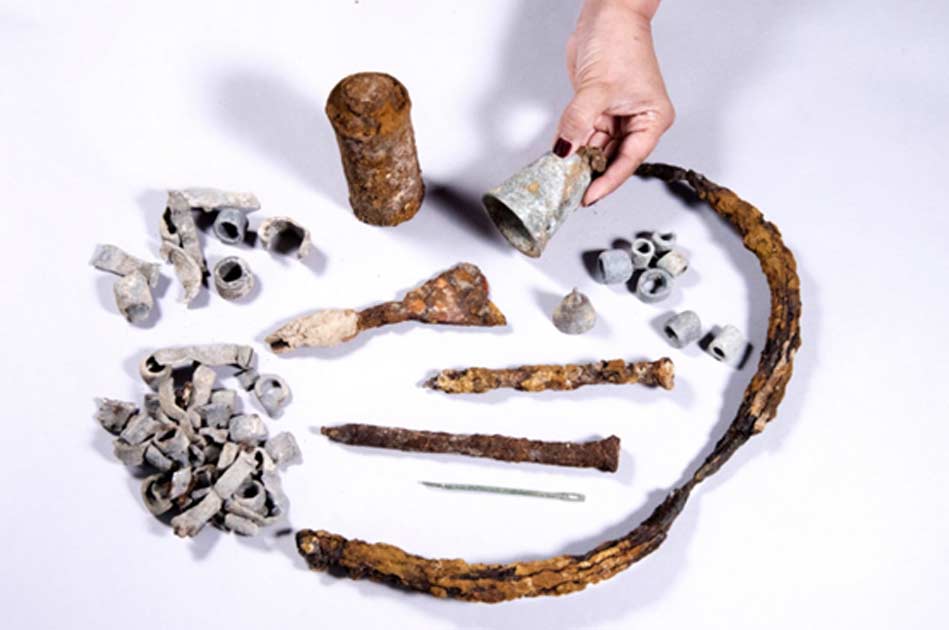500-Year-Old Fisherman House and Wealth of Artifacts Discovered in Historic City of Ashkelon
A building used by fishermen in the Ottoman period, which contained fishing weights and fishhooks, was exposed in an archaeological excavation conducted in Ashkelon
Excavations in the coastal city of Ashdod, have uncovered buildings that were once used by local inhabitants that were engaged in fishing along the Mediterranean coast during the Ottoman period (16 th-20th century C.E.)
Ashdod was an important coastal city on the Mediterranean coast of Palestine, during the Ottoman period. Numerous buildings from the port of Ashdod, including a large fort built in stone masonry have been exposed during previous excavations of the Mediterranean hub.
Now archaeologist excavating in the seaside port have uncovered two fisherman’s houses and a lookout tower, possible a lighthouse, all-dating to the Ottoman era.

Young people who worked on the archaeological excavation. Photographic credit: Clara Amit, courtesy of the Israel Antiquities Authority
The tower was situated on a lofty hilltop, and it looks out over the beach and Mediterranean Sea. From the tower one could signal and direct ships that were sailing between the ancient ports in Ashkelon and Ashdod-Yam the archaeologists involved said in an IAA press release.
“The fisherman’s house is divided into three rooms, and a wealth of artifacts was discovered in it that are indicative of its use: metal fishhooks, dozens of lead weights, a large bronze bell, and even a stone anchor. The building’s entrances were fixed in the north in order to prevent the high winds and sea storms from entering into it”, Federico Kobrin, one of the directors of the excavations said in an IAA press release.
This is the first time that a building was exposed in Ashkelon that we can attribute with certainty to the fishing industry explained the archaeologists.

Federico Kobrin, excavation director on behalf of the Israel Antiquities Authority, near the lookout tower. Photographic credit: Clara Amit, courtesy of the Israel Antiquities Authority
Ashdod - A Contested City
Ashdod can brag of a rich history. During the city's history it was settled by Philistines, Israelites, Byzantines, Crusaders and Arabs.
The first documented settlement in Ashdod dates to the Canaanite culture of the seventeenth century B.C.E. Archeological excavations have exposed the remnants of a fortified Canaanite city.
Three centuries later, the Sea Peoples occupied it. In biblical times Ashdod had become one of the five principal cities of the Philistines under their “axis lords” and evidently the religious center of Philistia with its worship of the god Dagon.
In 734 B.C.E. the city capitulated to Tiglath-Pileser III of Assyria and in 712 B.C.E. Sargon crushed a rebellion led by Ashdod´s king Azuri, due to the heavy taxes imposed by the Assyrian Empire. Afterwards, the city became the capital of an Assyrian province (Isa. 20:1). Although the city was situated on the via maris, the trade route near the sea, it was not directly on the coast but possessed an ancient port which was called Ashdod Yam ("Ashdod-on-the-Sea"). With the decline of Assyrian power, the Egyptian pharaoh Psammetichus I conquered the city after a siege of 29 years (according to Herodotus, 2:157).

Battle of Ashkelon, 1099 (public domain)
During the Maccabean period Ashdod (then called Azotus) came under attack by Judas Maccabaeus about 163 B.C.E. and later by Judas’ brother Jonathan about 148 B.C.E., the temple of Dagon being burned down in this second attack.—1 Maccabees 5:68; 10:84.
The city was rebuilt by the Romans about the year 55 B.C.E. and was generally known by its Greek name Azotus.
Top image: The finds that were discovered: metal fishhooks, dozens of lead weights, a large bronze bell, etc. Photographic credit: Clara Amit, courtesy of the Israel Antiquities Authority
By Sam Bostrom

















